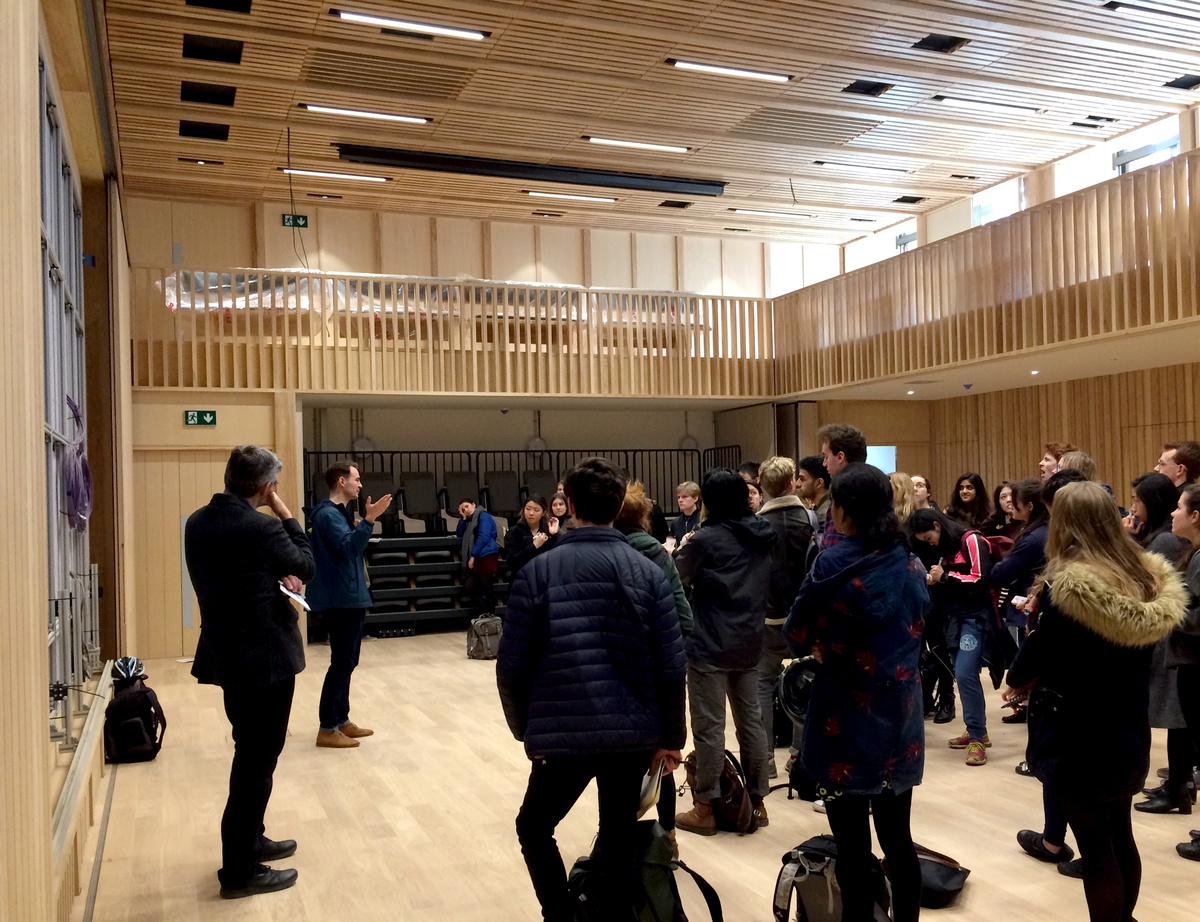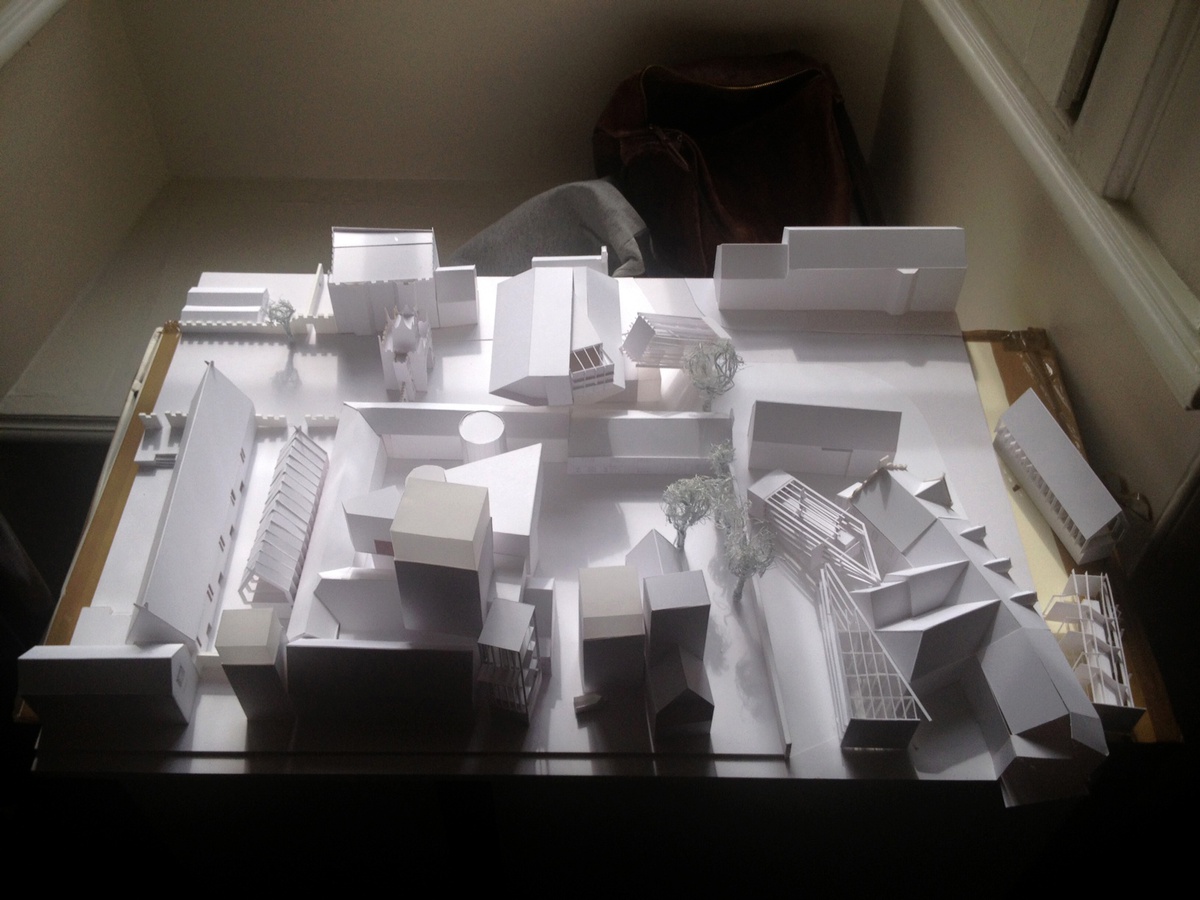CAMBRIDGE ARCHITECTURE STUDENTS TOUR OF JESUS COLLEGE
MARCH 2017

On Wednesday 1st March the University of Cambridge Year 2 architecture students visited our West Court development at Jesus College. They were invited by Professor of Sustainable Design Koen Steemers, a Fellow and Director of Studies at Jesus College. I gave a general introduction to the project in the recently completed auditorium and was asked to cover some more specific acoustic design issues to tie in with Professor Steemers’s recent lectures on acoustics.
It was great to experience the ash-lined auditorium space occupied. With the secondary glazing installed earlier in the week, there was no disturbance from noisy Jesus Lane outside and even the buzz of the busy building site beyond the four walls of the auditorium was not noticeable.
I really enjoyed the Q&A session and was surprised at the insightful questioning and level of engagement that the Year 2 students demonstrated. There were specific questions about acoustic design – Were different room shapes considered? – and more general questions about the architecture – What informed the architectural language of the Auditorium? How was the 100-year lifespan of the building considered in the selection of materials?
Having finished in the auditorium, we crossed the courtyard to the new café pavilion and ended the tour in the basement bar below. Here the acoustics are very different with glazed tiling to the walls and brass surfaces. It was interesting to discuss how the acoustic plaster soffits, the sprung floor and the ceiling vaults might affect the sound. Again probing questions were raised about design and sustainability but I got the sense there was another question on everyone’s mind – Shouldn’t every college bar have its own microbrewery?
A DAY OUT OF THE OFFICE
MAY 2014

We breathlessly boarded the 08.55 to Darlington. Like skilled waitresses we had kept our homemade, oversized, A1 box perfectly level throughout our chase through Kings Cross Station. The immaculate foam-board creation fitted perfectly on top of a double-seat on the near-empty train. East-Coast mainline rules are clear however; the guard reminded us that seats are for people only and at Peterborough we were duly ordered to deliver our carefully crafted friend to the dedicated luggage wagon at the front of the train.
The box was purposefully constructed to house a 1:150 context model of Bishop Auckland Town Square with ‘slot-inable’ building options for the site in question. The model was made for a meeting with Durham County Council and English Heritage at Auckland Castle that same afternoon.
Despite our ticket inspector’s fussiness, we were carried to our destination with the box and its contents in good order.
After a communal lunch with the review panel, the dozen-odd experts collected themselves around a table where the model had been assembled. The object took up so much space that notebooks occasionally and apologetically slid from the edges of the table.
For the following three hours, a multitude of building blocks representing different proposals for the new Welcome Building were inserted into the corner site. The new building is to link town and castle, engaging the new with the old, with our site at the axis of this pirouetting dance.
As we waltzed around the model, interchanging different pieces into our self-made jigsaw, a negotiation occurred between the many different people around the room, a parallel perhaps to the building itself.
During the second part of the afternoon, the presentation became more conceptual. The tower – the key feature of the proposal – was discussed in its meaning, shape and materiality. Was it a campanile, a siege tower, a lighthouse or a scaffold? Each version was debated with varying levels of approval or skepticism. We answered questions by pulling off bits of white card or finding any handy props to add on to the model; notepads, milk jugs and i-phones were used.
We left the meeting feeling excited, there was only this box to get all the way back to the office.
Image shows part of the paper model, with multiple versions scattered about, sitting on a windowsill after the meeting.
Anne Schroell studied at the Bartlett School of Architecture. She worked for Tonkin Liu and De Matos Storey Ryan as well as practices in Luxembourg and Austria before joining Niall McLaughlin Architects in 2006. The main projects Anne worked on are Deal Pier Café in Kent, Somerville College Student Accommodation in Oxford, Peabody Housing in London. She is currently running the Auckland Castle project which consists of 2 new buildings. One is a new gallery attached to the castle and the other is the Welcome Building and Tower for orientation and ticketing.

